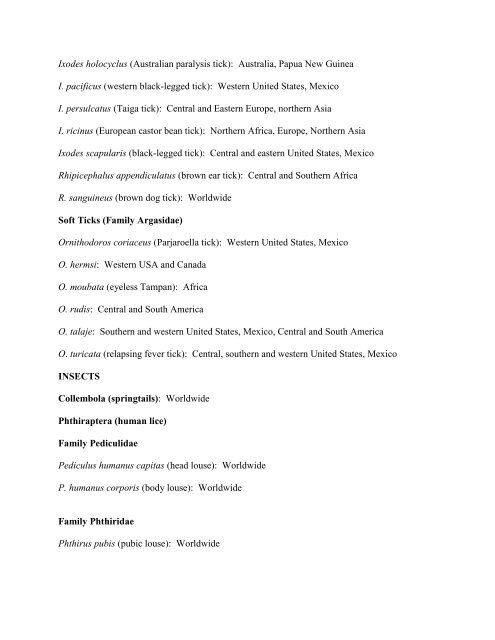Field Guide to Venomous and Medically Important Invertebrates ...
Field Guide to Venomous and Medically Important Invertebrates ...
Field Guide to Venomous and Medically Important Invertebrates ...
You also want an ePaper? Increase the reach of your titles
YUMPU automatically turns print PDFs into web optimized ePapers that Google loves.
Ixodes holocyclus (Australian paralysis tick): Australia, Papua New Guinea<br />
I. pacificus (western black-legged tick): Western United States, Mexico<br />
I. persulcatus (Taiga tick): Central <strong>and</strong> Eastern Europe, northern Asia<br />
I. ricinus (European cas<strong>to</strong>r bean tick): Northern Africa, Europe, Northern Asia<br />
Ixodes scapularis (black-legged tick): Central <strong>and</strong> eastern United States, Mexico<br />
Rhipicephalus appendiculatus (brown ear tick): Central <strong>and</strong> Southern Africa<br />
R. sanguineus (brown dog tick): Worldwide<br />
Soft Ticks (Family Argasidae)<br />
Ornithodoros coriaceus (Parjaroella tick): Western United States, Mexico<br />
O. hermsi: Western USA <strong>and</strong> Canada<br />
O. moubata (eyeless Tampan): Africa<br />
O. rudis: Central <strong>and</strong> South America<br />
O. talaje: Southern <strong>and</strong> western United States, Mexico, Central <strong>and</strong> South America<br />
O. turicata (relapsing fever tick): Central, southern <strong>and</strong> western United States, Mexico<br />
INSECTS<br />
Collembola (springtails): Worldwide<br />
Phthiraptera (human lice)<br />
Family Pediculidae<br />
Pediculus humanus capitas (head louse): Worldwide<br />
P. humanus corporis (body louse): Worldwide<br />
Family Phthiridae<br />
Phthirus pubis (pubic louse): Worldwide

















